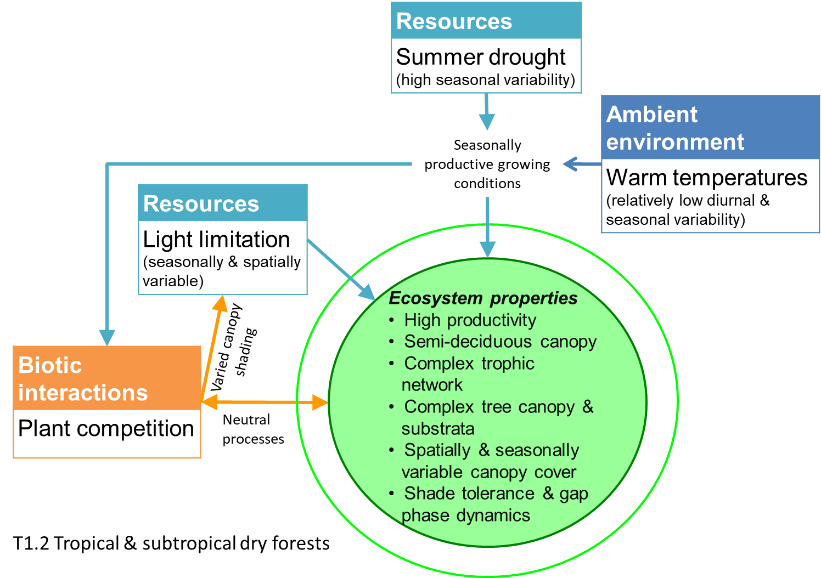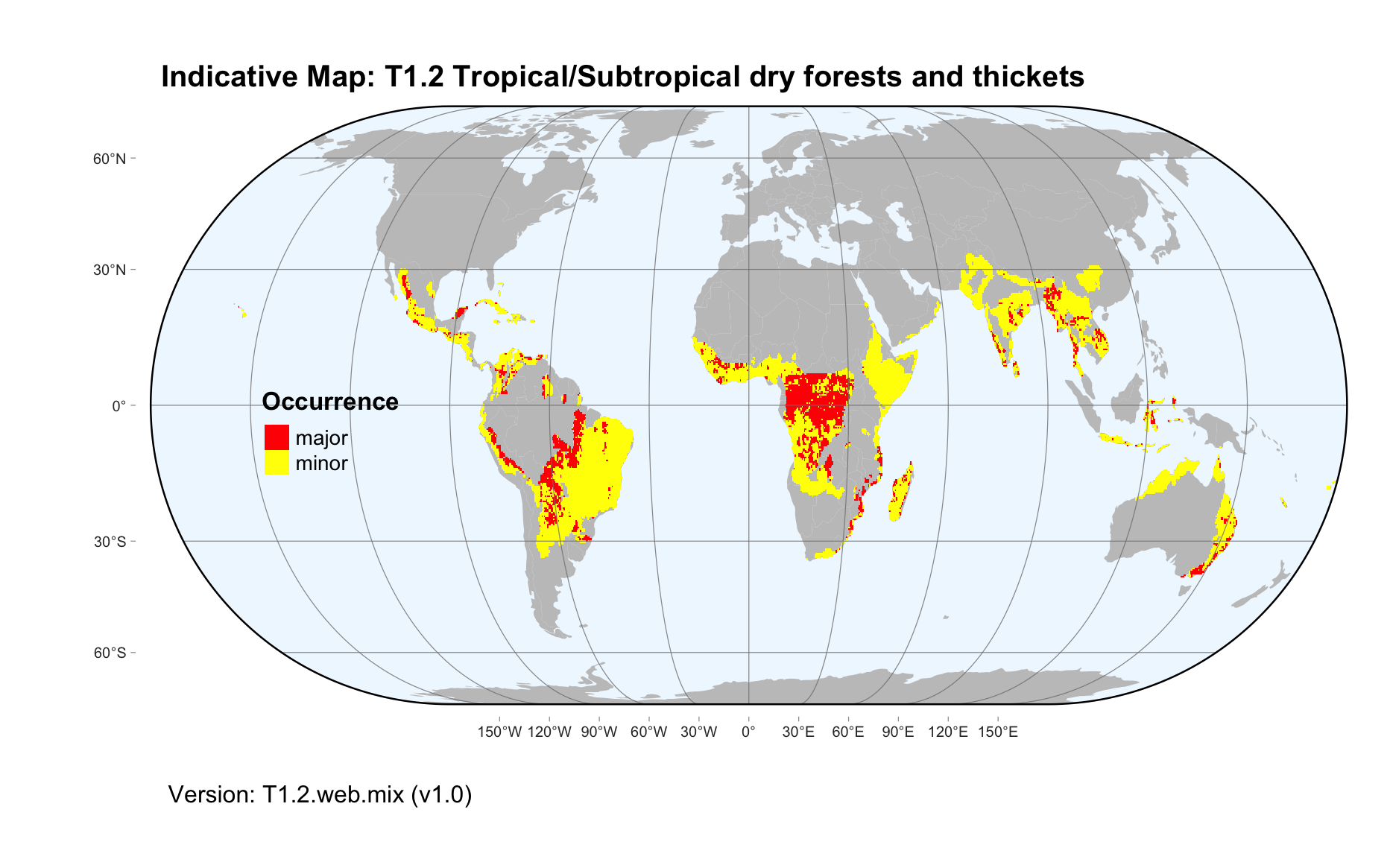Global ecosystem typology
Alternative site for the Global ecosystem typology with additional information for ecosystem profiles and indicative maps.
This site is maintained by jrfep
T1.2 Tropical/Subtropical dry forests and thickets
Biome: T1. Tropical-subtropical forests biome
Contributors:
(texts)
Tropical-subtropical dry forests and thickets are characterised by fertile substrates and seasonally dry conditions (~1800 mm per year, with a period of 3 to 6 months receiving less than 100 mm per month) that drive markedly seasonal patterns of productivity. Tree-diversity is high, with a variable mixture of evergreen and drought-deciduous trees, with abundant vines, but fewer epiphytes, ferns, mosses, and forbs, limited by seasonal drought. Abundant leaf litter is decomposed by fungi and microbes within complex foodwebs dominated by vertebrates of all kinds.
Key Features
Closed-canopy deciduous and semi-deciduous forests in warm seasonally wet/dry climates, diverse life forms.
Overview of distribution
Global wet/dry tropics & subtropics.
Profile versions
- v1.0 (2020-01-20): RT Pennington; J Franklin; NA Brummitt; A Etter; DA Keith
- v2.0 (2020-05-31): RT Pennington; J Franklin; NA Brummitt; A Etter; KR Young; RT Corlett; DA Keith
- v2.01 ():
- v2.1 (2022-04-06): RT Pennington; J Franklin; NA Brummitt; A Etter; KR Young; RT Corlett; DA Keith Full profile available at official site
Main references
Selected references for this functional group:
DRYFLOR, Banda-R K, Delgado-Salinas A, Dexter KG et al. (2016) Plant diversity patterns in neotropical dry forests and their conservation implications Science 353:1383-1387 DOI:10.1126/science.aaf5080
Pennington RT, Lewis G, Ratter J (2006) Neotropical savannas and dry forests: plant diversity, biogeography and conservation CRC Press, Florida
Murphy PG, Lugo AE (1986) Ecology of tropical dry forest Annual Review of Ecology and Systematics 17:67–88 DOI:10.1146/annurev.es.17.110186.000435
Bunyavejchewin SC, Baker P, Davis SJ (2011) Seasonally dry tropical forests in continental southeast Asia - structure, composition, and dynamics The ecology and conservation of seasonally dry forests in Asia WJ McShea, SJ Davis, N Bhumpakphan, (Eds), pp. 9-35. Smithsonian Institution Scholarly Press, Washington DC. ISBN 9781935623021
Diagrammatic assembly model

Maps
Maps are indicative of global distribution patterns are not intended to represent fine-scale patterns. The maps show areas of the world containing major (coloured red) or minor occurrences (coloured yellow) of each ecosystem functional group. See general notes on maps.
There are 2 alternative versions of the indicative map for this functional group, please compare description and sources below.
T1.2.IM.mix_v1.0
Datasets
- Resolve-Ecoregions-2017
- EarthEnv-LandCover-v1.0
Map references
Dinerstein E, Olson D, Joshi A, Vynne C, Burgess ND, Wikramanayake E, Hahn N, Palminteri S, Hedao P, Noss R, Hansen M, Locke H, Ellis EE, Jones B, Barber CV, Hayes R, Kormos C, Martin V, Crist E, Sechrest W, Price L, Baillie JEM, Weeden D, Suckling K, Davis C, Sizer N, Moore R, Thau D, Birch T, Potapov P, Turubanova S, Tyukavina A, de Souza N, Pintea L, Brito JC, Llewellyn Barnekow Lillesø JP, van Breugel P, Graudal L, Voge M, Al-Shammari KF, Saleem M (2017) An Ecoregion-Based Approach to Protecting Half the Terrestrial Realm, BioScience 67: 534–545. DOI:10.1093/biosci/bix014. Data-set available on-line
Tuanmu, M.-N. and W. Jetz (2014) A global 1-km consensus land-cover product for biodiversity and ecosystem modeling Global Ecology and Biogeography 23(9):1031–1045 DOI:10.1111/geb.12182
T1.2.web.mix_v1.0

Datasets
- Resolve-Ecoregions-2017
- EarthEnv-LandCover-v1.0
Map references
Dinerstein E, Olson D, Joshi A, Vynne C, Burgess ND, Wikramanayake E, Hahn N, Palminteri S, Hedao P, Noss R, Hansen M, Locke H, Ellis EE, Jones B, Barber CV, Hayes R, Kormos C, Martin V, Crist E, Sechrest W, Price L, Baillie JEM, Weeden D, Suckling K, Davis C, Sizer N, Moore R, Thau D, Birch T, Potapov P, Turubanova S, Tyukavina A, de Souza N, Pintea L, Brito JC, Llewellyn Barnekow Lillesø JP, van Breugel P, Graudal L, Voge M, Al-Shammari KF, Saleem M (2017) An Ecoregion-Based Approach to Protecting Half the Terrestrial Realm, BioScience 67: 534–545. DOI:10.1093/biosci/bix014. Data-set available on-line
Tuanmu, M.-N. and W. Jetz (2014) A global 1-km consensus land-cover product for biodiversity and ecosystem modeling Global Ecology and Biogeography 23(9):1031–1045 DOI:10.1111/geb.12182
Check: the Glossary / Profile structure / the public document